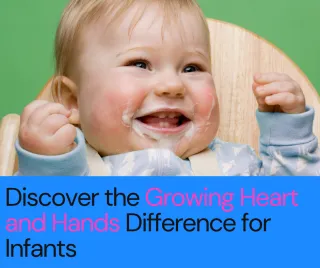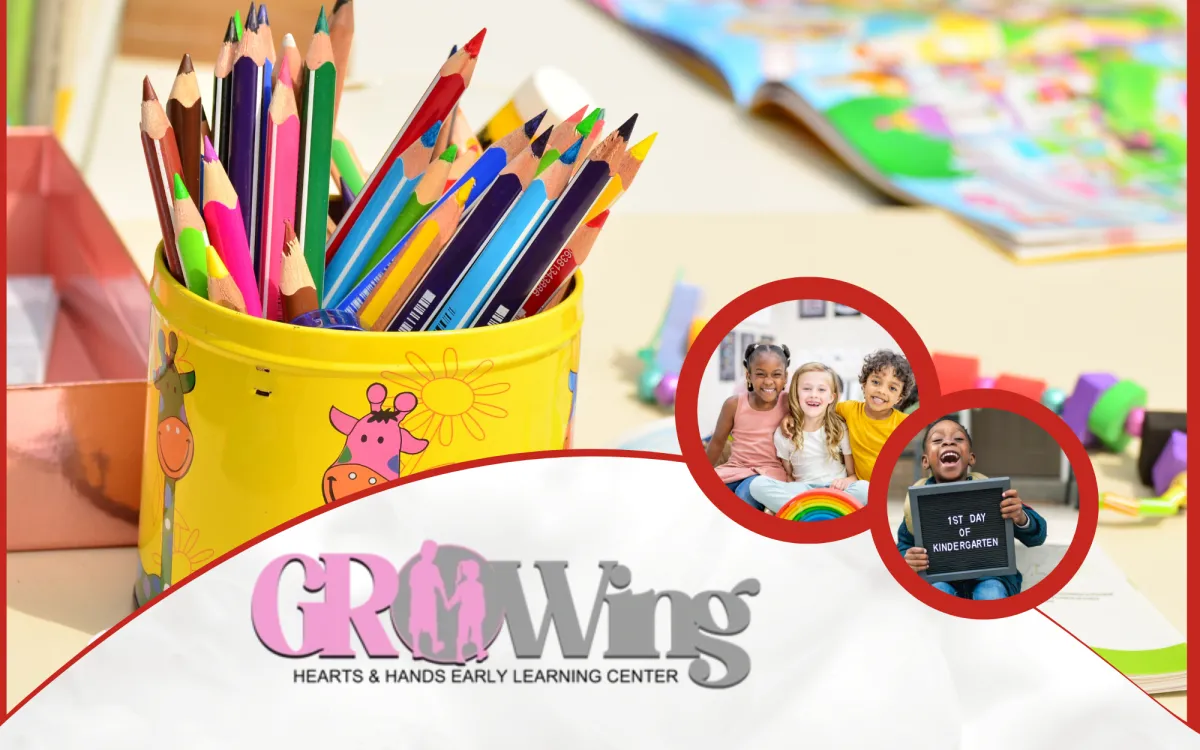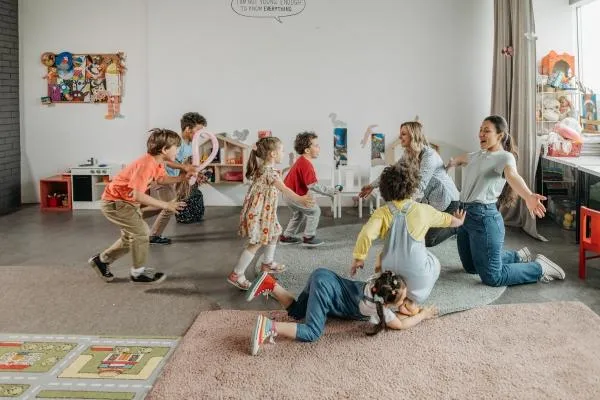
Best Daycare in Carrollton Georgia
Give us a call @ (678)601-3067
Growing Hearts and Hands
At Growing Hearts and Hands, we believe that every child deserves a nurturing environment where they can thrive academically, socially, and emotionally. Our state-of-the-art facilities and dedicated educators are committed to providing personalized learning experiences tailored to each child's unique needs.

Why Choose Growing Heart and Hands?
Customized Learning Plans:
We develop individualized learning plans that cater to your child's specific learning style and pace, ensuring optimal growth and development.

Qualified and Caring Educators:
Our team comprises certified professionals trained in early childhood education, CPR, and first aid, dedicated to fostering a safe and supportive learning environment.

Safe and Engaging Environment:
Our secure facilities are equipped with interactive play areas that encourage exploration and creativity, promoting holistic development.

Give us a call @ (678)601-3067
Schedule a Tour Today
Experience firsthand the vibrant learning community at Growing Hearts and Hands. We invite you to schedule a tour and discover how we can partner with you in your child's educational journey.


Learning for your Pre-Schooler
Three-year-olds are able to solve more and more problems, figure out unique ways to do something, and want to find out why – a lot! Learning Beyond helps you become a strong model, allowing children time to try and work through challenges while you ask important questions or provide support to children’s learning. Children’s skills in all developmental areas grow with these continued opportunities to be actively engaged in their learning and trusted as a learner. Learning Beyond provides quarterly benchmarks to help you stay focused on age-appropriate growth and excited learners.
Give us a call @ (678)601-3067

Behind the Smiles: What It’s Really Like to Be a Daycare Caregiver
A Day in the Life of a Daycare Caregiver
Behind the Smiles: What It’s Really Like to Be a Daycare Caregiver
Behind every crayon-colored picture and cheerful circle time song is a daycare caregiver balancing a dozen roles—educator, nurturer, referee, nurse, and comforter. The job may start early and end late, but the heart of it never stops: shaping young lives in their most formative years.
In this article, we step into the shoes of a caregiver at Growing Hearts and Hands Early Learning Center for a full day. What does it really take to keep a classroom of infants, toddlers, or preschoolers learning, safe, and loved from sunup to sundown? From managing daily routines to comforting emotional meltdowns, we explore the rhythm of caregiving with honesty, detail, and respect.
Early Morning: Setting the Stage for Learning and Love

The day begins before sunrise for many daycare professionals. By 6:30 or 7:00 a.m., caregivers are already on site, prepping bottles, setting up sensory bins, reviewing safety checks, and planning the day’s developmental activities. There’s a calm before the storm, a moment to breathe deeply before the little feet come rushing in.
Once children begin arriving, the emotional work starts instantly. One toddler is clinging to Mom’s leg, another is already chasing bubbles. The caregiver must tune into each child’s emotional state and regulate the environment accordingly—offering calm to the anxious and gentle energy to the early risers.
Key Takeaways:
Preparation begins early to ensure a safe, clean, welcoming environment.
Emotional regulation is a primary skill; caregivers model calm, empathy, and responsiveness.
Drop-off is often the most emotionally taxing part of a child’s day.
Morning Activities: Guiding Little Minds Through Play
After drop-off, structure takes center stage. Morning routines often include:
Circle time (songs, stories, weather charts)
Free play with guided learning stations (blocks, puzzles, dramatic play)
Outdoor exploration when weather permits
The caregiver isn’t simply “watching children.” They are intentionally teaching. When a child struggles to share a toy, it’s a teachable moment. When another says their first complete sentence, it’s a developmental milestone. Through games, songs, and hands-on learning, caregivers support cognitive growth and social-emotional learning in real time.
Key Takeaways:
Every activity is infused with intentional teaching and observation.
Social conflicts are reframed as opportunities for empathy-building and skill development.
Play is the primary language of early learning.
Midday: Meals, Diapers, and Naps
Lunch and hygiene routines are their own kind of choreography. Allergies must be monitored, preferences respected, and transitions handled with care. It’s not uncommon for caregivers to:
Feed infants while simultaneously encouraging self-feeding in toddlers
Change up to 20 diapers in a day while maintaining sanitation protocols
Guide children through potty training with patience and encouragement
Then comes nap time—a sacred window. Once all children are resting, caregivers use the time to clean, sanitize, log observations, and reset the classroom. It’s also when caregivers might take their only true break.
Key Takeaways:
Caregiving includes rigorous hygiene, safety, and health protocols.
Naptime is a vital transition that restores energy—for both children and staff.
Physical caregiving (feeding, diapering) is deeply tied to trust and relationship-building.
Afternoon Adventures: Exploration and Emotional Coaching
Afternoons are often more relaxed, but no less important. The day’s second wind brings a return to:
Creative arts and crafts
Science or sensory experiments
Outdoor gross motor play
Conflicts sometimes spike here, especially as children become tired. Caregivers step in not just as peacekeepers, but as coaches—helping children name their feelings, breathe through frustration, and find solutions with peers.
The magic lies in the little moments: a child learning to zip their coat, a baby taking first steps, a quiet “I missed you” during pick-up. These milestones, often invisible to outsiders, define the soul of caregiving.
Key Takeaways:
The caregiver’s role shifts from guide to coach—especially with emotional regulation.
Outdoor and open-ended play provide critical opportunities for autonomy and problem-solving.
Moments of quiet connection often carry the most developmental weight.
Pick-Up Time: A Day’s Worth of Progress in One Goodbye
By late afternoon, the children begin to leave. The caregiver’s role evolves once more—communicator and connector between the day’s experiences and the parents’ understanding of their child’s growth.
Brief conversations at pick-up often include:
Highlights of the child’s learning or behavior
Food/nap updates
Gentle guidance for follow-up at home
Then the room quiets. The toys are cleaned again. Notes are logged. And caregivers reflect on the day—on what went well, what challenged them, and the joy of watching each child grow, day by day.
Key Takeaways:
Family partnerships are built through daily communication and trust.
Caregivers offer insights that deepen parent understanding and support.
The emotional labor continues long after the children go home.
The Caregiver’s Heart: Exhausted but Fulfilled

Daycare caregiver is often undervalued and misunderstood. But it is, without a doubt, one of the most demanding and rewarding professions. It’s about wiping tears, celebrating milestones, and holding space for both chaos and calm—all while shaping the very foundation of a child’s development.
Caregivers carry deep emotional labor with little fanfare. But the payoff? A classroom filled with growth, safety, joy, and the tiny voices that say “I love you” without even knowing the full weight of the words.
Final Thoughts and Call to Action
The next time you drop off your child, remember that behind the door is someone showing up with their full heart. A daycare caregiver is not “just watching children”—they are mentoring, nurturing, guiding, and protecting your little one through the most impressionable moments of life.
Want to meet the caregivers behind the magic? Schedule a tour at Growing Hearts and Hands Early Learning Center today or share this article with a fellow parent who needs to know they’re not alone. Let’s celebrate those who care with both hands and hearts.